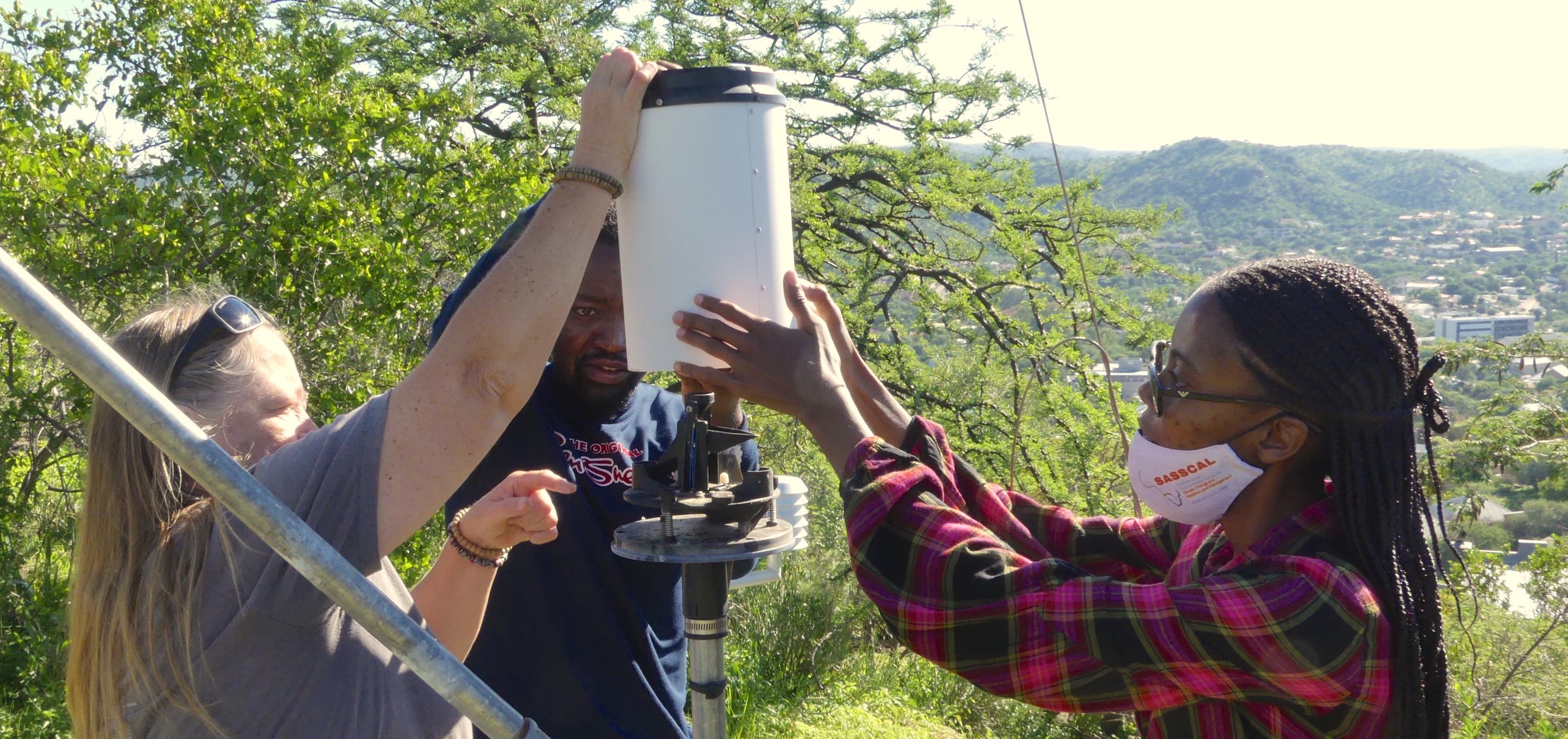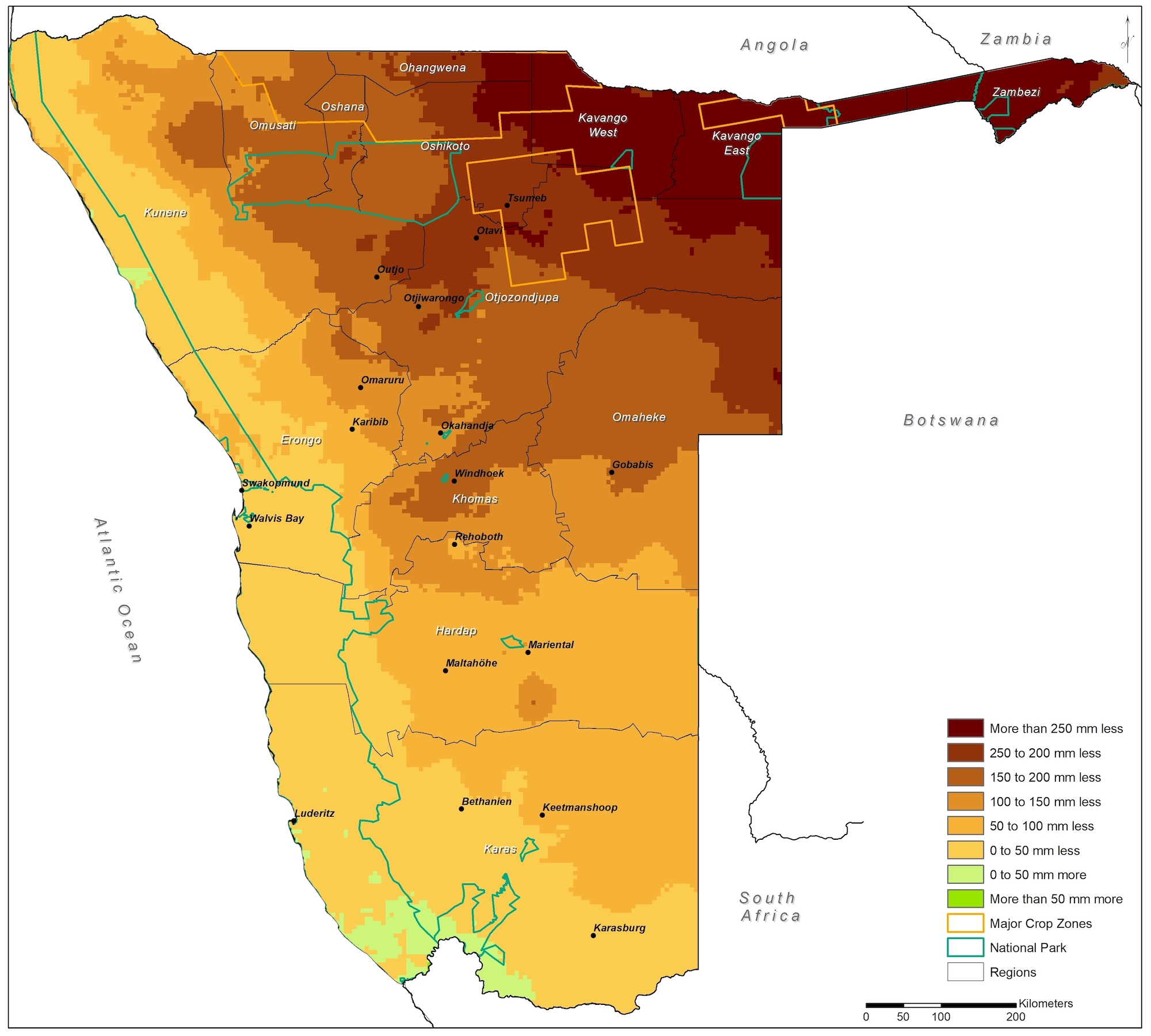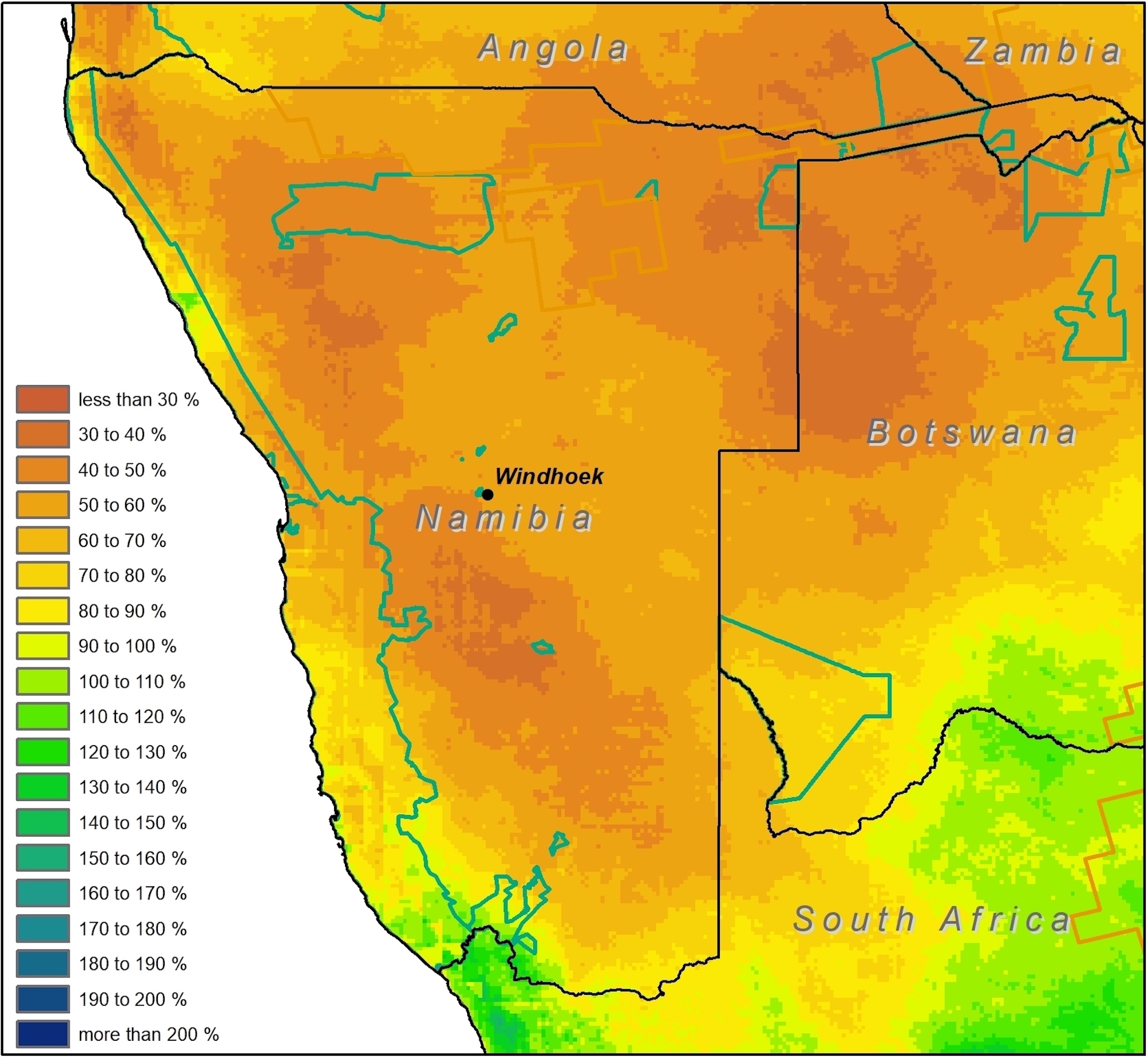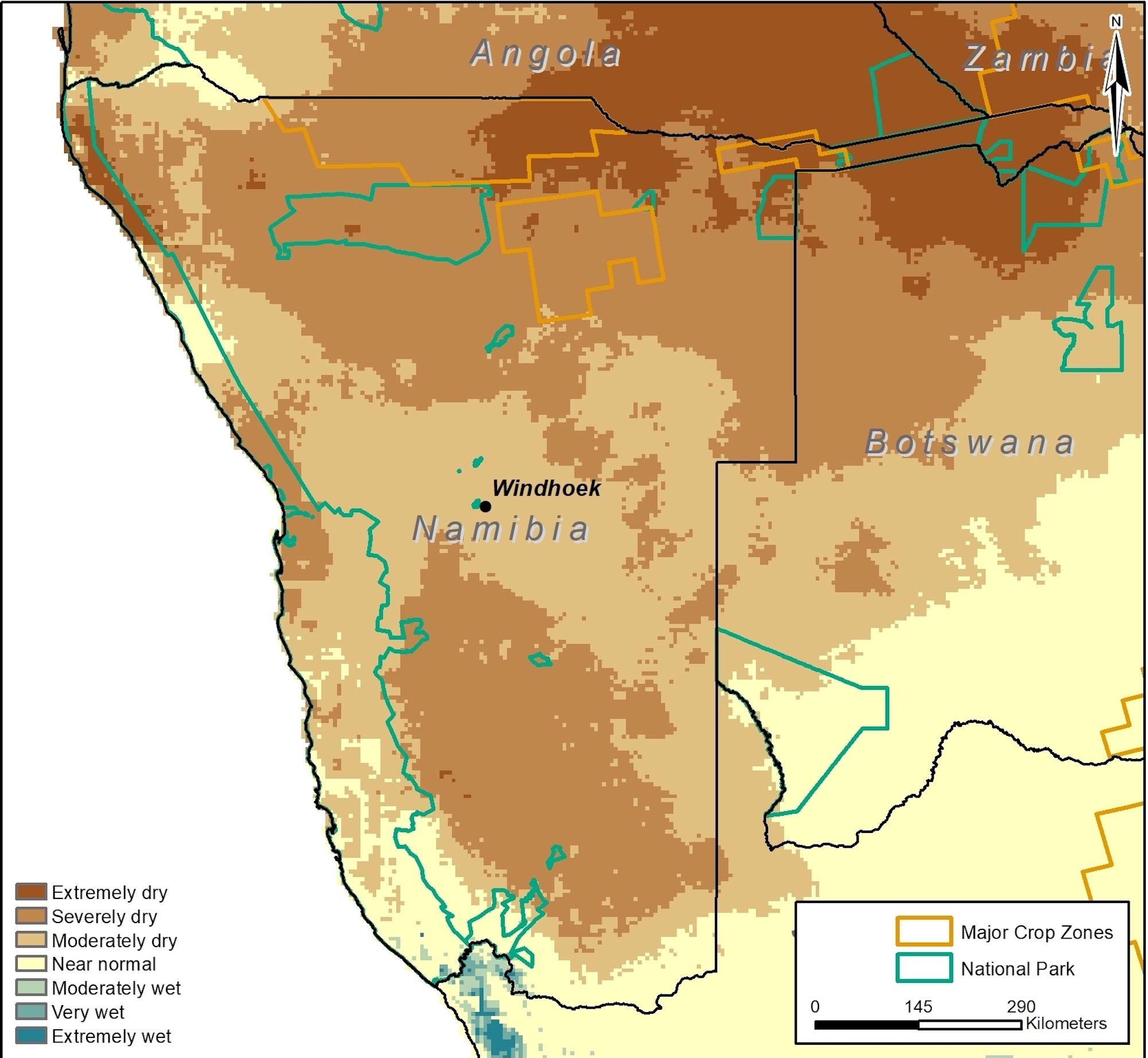
Namibia's climate and the need to adapt to an uncertain future
10th November 2023
10th November 2023
Historically, Namibia has been a country trapped by, and vulnerable to, a highly erratic rainfall regime. Therefore, the questions Will it rain? and Will there be grazing? affect the well-being of most of Namibia's population and have a direct impact on the country's fledgling economy.
The threat of drought is a real and ever-present phenomenon in Namibia. Water security relies mainly on dams or the precious and finite resource of groundwater. The majority of the population lives in northern Namibia and is largely dependent on rain-fed subsistence farming. Namibia's agricultural pride, its culture of pristine open-range livestock farming, is also dependent on the whims of the rainfall regime.
Therefore, in the spring of 2022, farmers and governments of southern Africa rejoiced when various regional and international meteorological services predicted normal to above-normal rainfall for most of southern Africa, including Namibia, in the 2022/23 rainy season. However, the current season has once again highlighted Namibia's vulnerability to unpredictable rainfall. Contrary to the hopeful forecasts, Namibia and most of the southern Africa region experienced the second-poorest rainfall since 1981/82. Only the 2018/19 season has been worse.
In addition to this uncertain and precarious reliance on the rainy season, Namibia has woken up to a new reality, where climate science warns of a statistically likely future of a more erratic rainfall regime exacerbated by a warmer climate. Climate research has already established warmer temperatures as the new reality. In Namibia, for example, the past 13 years have seen the best and the worst rainy seasons in over 40 years.

When is a rainy season normal?
In Namibia, as in most of southern Africa, the hydrological year runs from October to the end of September of the following year. No significant rainfall is expected from June to September.
To understand what normal rainfall is, one needs historical rainfall data. Due to Namibia's erratic rainfall regime, a sufficiently long historical record of rainfall data is required to define normal. In statistical terms, normal is not synonymous with average: the former is derived from 30 years of rainfall (precipitation) data and the latter from 10 years.
How do we monitor rainy seasons?
Data is the most challenging aspect of climate science. Sufficient and scientifically sound data is essential if climate scientists are to attempt to predict the climate of the future. Both the length of the historical record available to us and the spatial distribution of the meteorological stations affect our understanding of the trends and variability of a rainfall regime. For instance, not having enough stations around the famous Maize Triangle between Otavi, Grootfontein and Tsumeb would mean that the higher rainfall associated with this microclimate would not be captured accurately.
Namibia's rainfall record is inadequate both in terms of the spatial distribution of weather stations and the period over which these stations have been active. Recognising this gap, the Southern African Science Service Centre for Climate Change and Adaptive Land Management (SASSCAL), with support from Germany's Federal Ministry of Education and Research (BMBF), has funded the installation of 64 Automatic Weather Stations (AWSs) in Namibia and a further 100 stations in Angola, Botswana, South Africa and Zambia since 2010. This valuable resource serves scientists, farmers and the general public (see box at end for links to the portals mentioned here).
To obtain a comprehensive picture of rainfall in southern Africa over extended periods of time, it is essential to go beyond the limited data available from rain gauges and weather stations on the ground. SASSCAL uses the Climate Hazards Group Infrared Precipitation with Stations (CHIRPS) dataset, which spans more than 35 years. Developed by the Climate Hazards Center, CHIRPS expertly combines precipitation estimates from ground-based gauges, including the SASSCAL WeatherNet stations, with precipitation data from satellites. Satellites, equipped with advanced instruments designed to measure atmospheric conditions, use this information to generate precipitation data. The data is updated monthly and is freely available via the SASSCAL WeatherNet Portal.
Various precipitation data products derived from CHIRPS 2.0, including maps and datasets, as well as other satellite-based datasets and products such as land surface temperature, burned areas and vegetation indices are available free of charge on the SASSCAL Data and Information Portal.

Back to the 2022/23 rainy season
A simple comparison of the total rainfall of the 2022/23 season with the historical average season total shows that for most of Namibia, the total rainfall for the 2022/23 rainy season was considerably less than the historical average.
However, as average rainfall is quite variable in different parts of Namibia, it is difficult to put the deviations in millimetres of rainfall into context. Meteorological indicators allow us to assess seasonal rainfall and determine whether a season can be classified as normal, dry or wet. For instance, expressing the season's total rainfall as a percentage of the historical average rainfall total allows us to classify a season as normal, above normal or below normal. For the 2022/23 season, the map of the percentage of the season's total rainfall suggests that most of the country had below average rainfall.
Similarly, the Standardised Precipitation Index (SPI) is an indicator proposed by the World Meteorological Organisation that is also used to objectively assess whether a rainy season was normal, good or bad. More importantly for Namibia, the SPI is relevant to objectively conclude if a rainy season can be classified as a drought year, by comparing it with the available historical record. The SPI for the 2022/23 rainy season suggests that much of Namibia was moderately to severely dry, with Kavango West and Zambezi being extremely dry during the 2022/23 season.


Comparing the average annual rainfall total for the 2022/23 season to date with the average annual rainfall in the previous 41 years suggests that, on average, all regions of Namibia have received substantially less rainfall than could be expected according to the preceding 41 years.

How does SASSCAL support climate research and adaptation?
SASSCAL, under the leadership of its Executive Director, Dr Jane Olwoch, has launched its new research programme (SASSCAL 2.0) to help prepare the southern African region for the impending consequences of climate change. Notably, Namibia features prominently, being included in nine out of the thirteen research projects. A collective of regional and global scientists will pool their expertise to devise tangible, impactful and sustainable solutions to the climate-induced challenges that threaten Namibia's food and water security.
At the launch of the SASSCAL 2.0 Research Programme in April 2023, Professor Francois Engelbrecht, a climate change scientist at Wits University, reminded the research community that “Our science has to be better than ever before!”. Research needs to be trans-disciplinary and trans-boundary. Researchers must work together to ensure that the southern African region can identify the risks of climate change, ensure the much-needed awareness and the necessary preparedness for events such as droughts and floods.
The SASSCAL 2.0 research portfolio is fully collaborative and trans-disciplinary to ensure realistic, effective and sustainable solutions to Namibia's food and water security challenges. Among other goals, the research promises to provide more reliable and high-resolution climate projections, identify more resilient crops that can withstand the whims of an erratic climate and identify sustainable and alternative land use practices. SASSCAL further aims to provide solutions to scarce water resources, and amongst others, identify methods of ensuring rangeland health.
SASSCAL 2.0 will support academic and non-academic capacity development to further ensure climate change adaptation and sustainable land management. At least 60 Bachelor, 60 Master and 25 PhD students will be facilitated, thus contributing to a knowledge-based society in southern Africa.
SASSCAL strives to ensure that its contribution to research on climate change and adaptive land management as well as to capacity development will help bolster Namibia against the effect of a hotter and possibly more erratic climate.
About SASSCAL
The Regional Secretariat of SASSCAL resides in Windhoek, Namibia. SASSCAL has National Nodes in each of its member countries – Angola, Botswana, Namibia, South Africa and Zambia. For more information see www.sasscal.org.
For articles on similar topics, please click one of the following options:
For more great articles from Conservation Namibia see below...
Conservation Namibia brought to you by:
We use cookies to monitor site usage and to help improve it. See our Privacy Policy for details. By continuing to use the site, you acknowledge acceptance of our policy.











